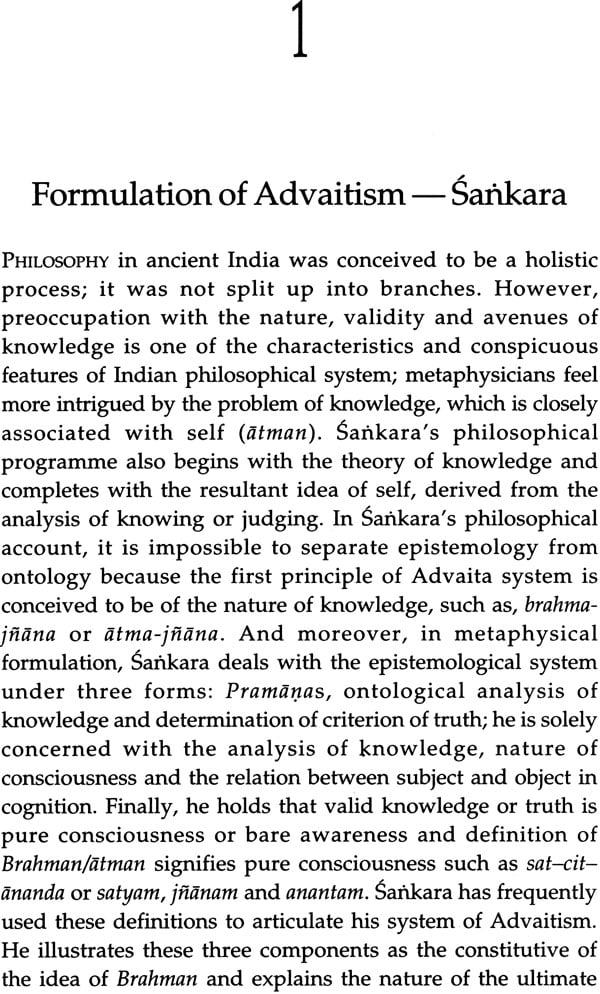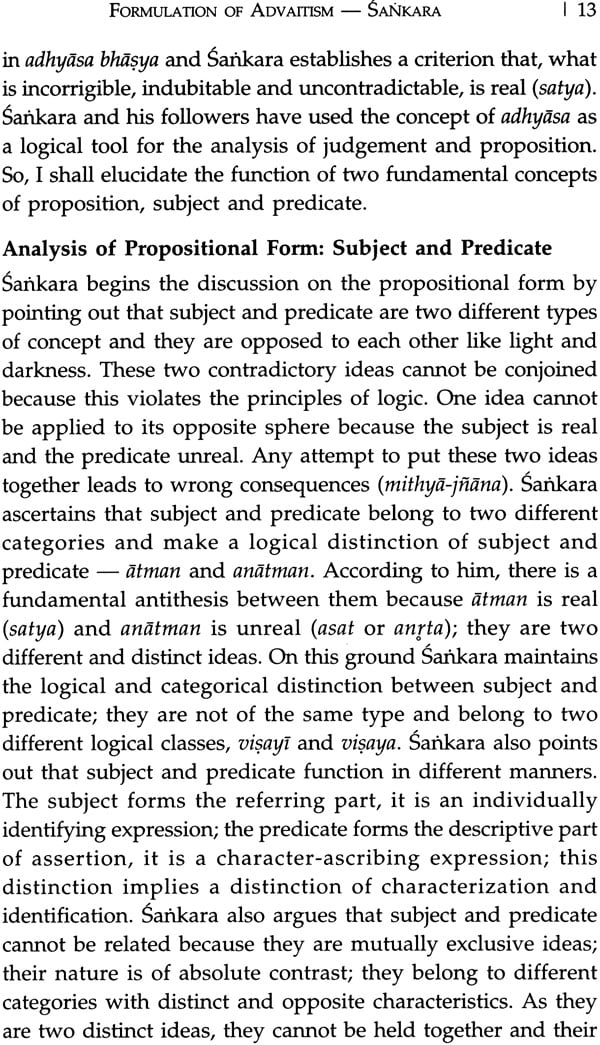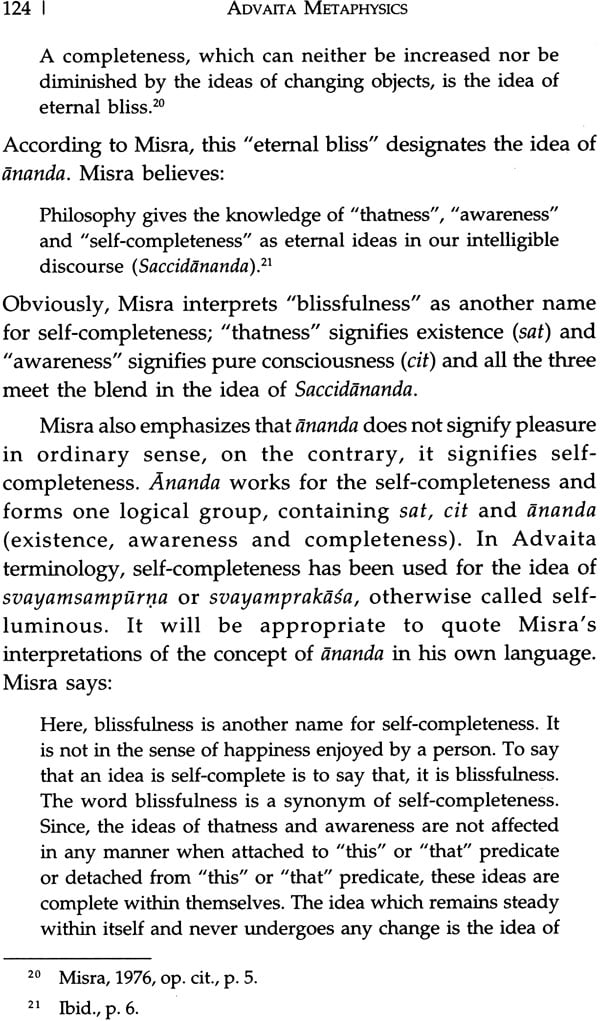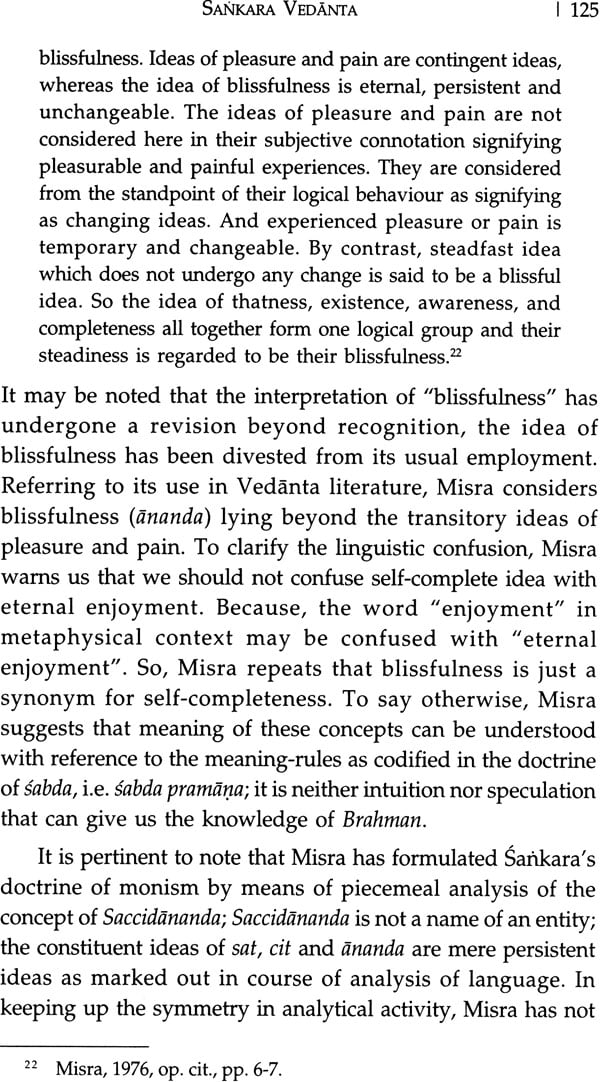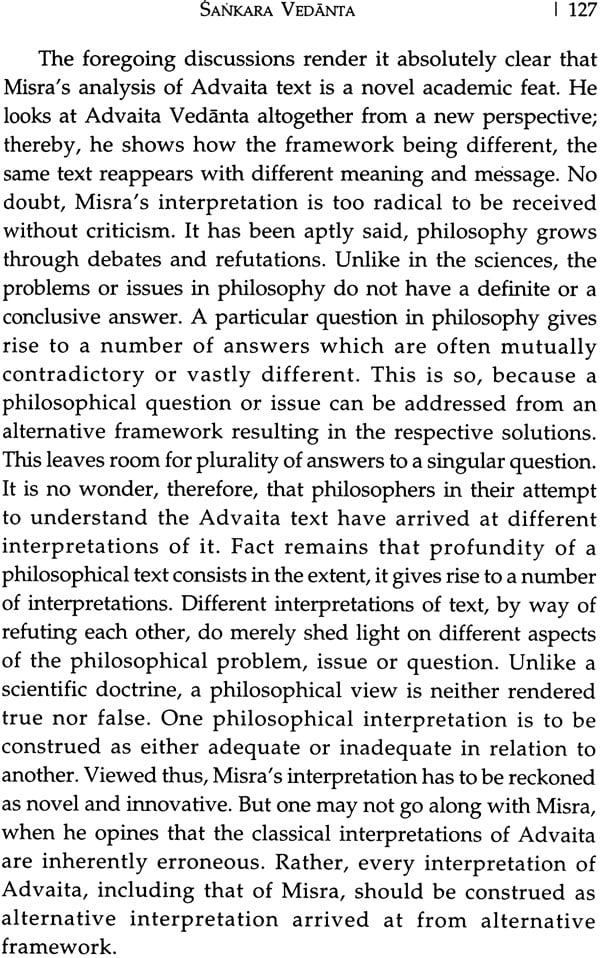
Advaita Metaphysics: A Contemporary Perspective
Book Specification
| Item Code: | NAH547 |
| Author: | Tapti Maitra |
| Publisher: | D. K. Printworld Pvt. Ltd. |
| Language: | English |
| Edition: | 2014 |
| ISBN: | 9788124607473 |
| Pages: | 194 |
| Cover: | Hardcover |
| Other Details | 8.8 inch x 5.8 inch |
| Weight | 370 gm |
Book Description
Upanisads have been viewed differently by commentators down the centuries. Philosophers have brought in their native presuppositions in interpreting the Upanisadic texts. Advaitavada (monism) of Sankara stands out conspicuous among the varied interpretations of the Upanisads. Ontology, having been basic and fundamental, logic, epistemology and ethics are parasitic on it. Thinkers like C.R. Malkani, K.S. Murty and C. Misra offer alternative perspectives in under- standing concepts and doctrines of the Upanisads.
This book undertakes the study of Advaitavada of Sankara in its depth and extension. It spells out the relative cogency of Malkani's understanding of Advaita Metaphysics and Methodology, Murty's Critique of Advaita (non- dualism) and Misra's Philosophical Construction of Advaita from a linguistic perspective. This volume centres around the formulations of the Advaita theory of monism on the basis of epistemological and logical analysis of knowledge in Adhyasa Bhasya.
This title is a significant addition to the existing literature on Advaita philosophy and shall be of profound interest for scholars at large.
Dr Tapti Maitra has an eventful academic career, with post-graduation from the University of Calcutta. She joined Orissa Education Service and sub- sequently, Post Graduate Department of Philosophy, Utkal University. Besides several research publications to her credit, she has authored A Constructive Study of Advaita Conception of Mind. She is greatly devoted to the study of Advaita Vedanta of Sankara. She is known for her in-depth study of the seminal concepts and foundational issues in Advaita Vedanta from the logico-linguistic perspective.
THE Upanisads are the earliest philosophical texts of the world. Profundity of a philosophical classic consists in the extent to which it tends itself to alternative interpretations. Needless to say that the Upanisadic texts have been viewed differently by commentators (bhasyakara) down the centuries, of which the monistic interpretation of Upanisadic metaphysics by Sankaracarya stands out conspicuous. An intimate reflection on the varied interpretations brings home the fact that, by and large, thinkers and scholars have read their native presuppositions and mystical convictions into the Upanisadic texts. Ontology is construed as basic and fundamental. Logic, epistemology and ethics therein are thought to be parasitic on metaphysics. There are a host of contemporary thinkers like G.R. Malkani, K.S. Murty and many other scholars who offer alternative perspectives and novel vistas to find new inroads into understanding the doctrine of Upanisads. Tarkapada Bhasya is a significant exercise to spell out the logical system embedded in the text.
While adjudging the coherence and adequacy of classical interpretation, I have examined at length how logic and epistemology stand out as fundamental and can constitute as a starting point of excursion to the understanding of Advaita metaphysics. I have undertaken a faithful analysis of Advaitic logic and epistemology which provides a secure basis to the monism of Upanisads, as revealed in the notion of Brahman or Atman.
The central theme of the proposed work is the exposition of the formulation of the Advaita theory of monism on the basis of epistemological and logical analysis of knowledge in Adhyasa Bhasva. I have argued how the Advaita system is essentially a logical enterprise and seeks to eliminate speculative or metaphysical ideas. I have addressed the fundamental questions of Advaita enterprise as a prelude to the interpretation of Vedanta-Sutra. Sankara elaborately discusses the structure and limits of human knowledge and pointed out the perpetual logical error involved in the judgemental knowledge expressed in the propositional form. Consequently, Sankara denounces the validity of factual knowledge and elucidates the nature of true knowledge bereft of any description whatsoever. This kind of knowledge has been characterized as Truth and ultimate Reality. These twin ideas represent the concept of Brahman.
Sankara had demonstrated the method of elimination of factual knowledge and has pleaded in favour of a method of acquiring valid knowledge (paramarthika jnana). With the prefatory demonstration of Sankara’s philosophical investigation, I have proceeded to unearth the logical foundation of Advaita metaphysics spelt out in the research works of some eminent Advaita scholars.
I have subjected G.R. Malkani's review of Advaita metaphysical concepts as well as Advaita methodology to critical scrutiny. His philosophical work deals with the principal tenets of Advaita metaphysics, elucidating the doctrine of monism with its accompanying characteristics. The characteristic feature of the treatment of the subject has been underlined.
Malkani offers a rational interpretation of the traditional thinkers in consonance with scriptural statements. In course of his exposition of Indian spiritualism, he seeks to do away with the mystical underpinnings. He has brought out the theory of spiritualism of Advaitins by rational and logical arguments. He moots the thesis that spiritualism is an integral part of human life and idealism does not connote any set- ideal beyond human aspirations. In this context, Malkani has illustrated the social applicability of supreme value, i.e. ananda. Accordingly, his philosophical review reconciles Advaita philosophy with Advaita theory of religion and morality. In his exposition of Advaitism and religion, Malkani has made a remarkable contribution in viewing Advaitism as "the religion of knowledge". According to him, the doctrine of Absolutism is the meeting point of religion and philosophy. He defines Advaitism as synthesis of philosophy and religion.
Malkani pleads in favour of a special type of Advaita methodology, viz., supernormal method. I have attempted to show that the word "supernormal" does not denote any supersensible element. He has explained the meaning of revealed words - sabda, sruti, etc. - under the rubric of supernormal method for acquiring the knowledge of Brahman (brahma-vidya). While narrating the course of supernormal method, Malkani is explicit in expounding spiritualism as the concept of ananda, the essential part of the definition of Brahman. He has underlined the role of ananda in organizing all modes of human activities for the attainment of highest goal, i.e. moksa, the supreme value. Further, he has emphasized that the "supreme value" is a social value which can be achieved in this life cycle through cultivation of spiritual discipline. This introduces a new dimension in applied philosophy.
K.S. Murty is a prolific writer on various facets of philosophy. In the proposed project, I have confined myself to Murty's interpretation of the central metaphysical concept of Absolute/Brahman, substantiated by philosophical method. The salient features of his celebrated work on Advaita Vedanta, Revelation and Reason in Advaita Vedanta have been brought into bold relief. Murty's criticism of Advaita monism reveals a unique perspective to understand the monism of Advaita. I have sought to give proper estimation of his critique of non- dualism and logical definition of Brahman, illustrated by him; my chief concern is to present Murty's analysis of the Upanisadic definition of Brahman, viz. sat yam, jnanam and anantam.
After the assessment of Murty's analysis of the metaphysical idea, I have set out for reviewing the methodological concepts, viz. reason and revelation. Murty has not discarded the role of reason in the Advaita method. Rather, "reason" acts as a subordinate means in the act of revelation of God as well as in acquiring the knowledge of Brahman. Accordingly, the notion of "revelation" has been treated as a higher type of knowledge. Revelation surpasses human reason but does not contradict it. He has rightly pointed out that higher knowledge is not incompatible with reason and logic. Moreover, man can distinguish between higher knowledge and lower knowledge by virtue of his rational faculty. Consequently, Murty clarifies that there is compatibility between higher knowledge and the rational or logical. Thus Murty effects a compromise in the last part of his book, mentioned above.
Murty adduces polemics against Advaita monism while expounding the "revelation of Brahman". He explains that revelation involves of dual concepts - the revealer and the revealed. This duality vitiates the doctrine of oneness of Brahman. He appeals to the scriptural statements to fortify the thesis of non-dualism. Murty argues from logical standpoint and refutes the concept of non-dual Brahman because of the dual activity involved in the process of revelation. This seminal point has been addressed with rigour and I construe it to be the major contribution of Murty, in his review of Advaitism. I have sought to discuss and evaluate G. Misra's reinterpretation of Advaita system, especially the reconstruction of Advaita metaphysics by applying the analytical technique. Misra is the first Indian to pronounce boldly that Sankara is not a dogmatic philosopher but a linguistic philosopher. Misra's philosophical enterprise has been solely concentrated on linguistic philosophy. He applies the method of linguistic analysis to resolve philosophical problems and issues in Advaita philosophy.
I have addressed myself to the basic features of Misra's evaluation on Sankaras philosophical programme and discussed the major aspects of Misra's work on Advaita Vedanta. Misra confines himself to the theory of logic and language in his deliberation of Advaita theory of metaphysical essence. Misra has examined all the logical arguments of Sankara to show that Advaita theory of Reality is based on the analysis of the nature and function of language and descriptive discourse. He has sought to show that adhyasa (erroneous judgement) involves due to the application of attributive word to the subject, aham (the symbolic expression of Atman). He contends that Atman/Brahman cannot be represented in language or expressed in proposition because all propositional forms involve logical mistake. He elucidates how all empirical judgements combine two different types of concepts and thereby violate logical principle.
Misra's analysis of meaning-rules and language brings out the essential feature of the theory of language in Advaita philosophy. He has demonstrated how according to Sankara, descriptive language, by its very nature, can never be complete in independent usage. Because of this incompleteness of meaning of descriptive words, Sankara prefers demonstrative symbols without descriptive features, such as aham, idam and tat (I, this, that) as the basic concepts of Advaita metaphysics. In his discourse on Advaita metaphysics, Misra has offered an extensive account of analytic philosophers like Russell, Wittgenstein and Strawson. In this part of discussion, Misra underlines the supremacy of Advaita system by comparing the Absolutism of Bradley.
I have also examined Misra's views on epistemological problems. He has defended Sankara's arguments against perceptual knowledge because of the possibility of mis-description and misapplication of concepts in perceptual statements. He has elaborated various kinds of problems of perception in the illustration of the concept of adhyasa. Finally, Misra has sought to explicate how Sankara formulated the logical doctrine of metaphysical essence, Brahman, discarding descriptive language. Besides, he has elucidated how Sankara pleads in favour of the idea of non- qualified existence, non-qualified experience and non-qualified bliss as the ultimate concepts, because all these ideas have built-in sense of logical certainty. In this context, Misra claims that Sankara has analysed the meaning of pure existence, pure consciousness and pure bliss (sat-cit-ananda) as the formal properties, which are integral to the fundamental concept, Brahman or the Absolute.
Epilogue: In this section I have given a synoptic evaluation of salient points addressed in the preceding chapters. In a nutshell, I have sought to summarize and review all that have been discussed so as to make this work accessible to scholars at large.
To compute the principal ideas of this research programme, I can only say that I have attempted to understand the Advaitavada of Sankara from a contemporary perspective. My endeavour has been to reveal the academic excellence of the different types of models of interpretation in distinctive ways. To excel the excellence further, I would like to add a few lines on the novelty of the constructive interpretation of K.C. Bhattacharyya. Bhattacharyya's name is not widely known because of abstruse expression of his views on Vedanta. Scholars like T.R.V. Murty and G.R. Malkani have been profoundly influenced by the original thinking of KC. Bhattacharyya and acknowledge his unique creativity in relating classical German philosophy to the key issues of Advaita Vedanta. However, as a research worker, I find a new trend in Bhattacharyya's constructive interpretation of Vedanta. I mention only the seminal points of his constructive interpretation.
Bhattacharyya undertakes constructive interpretation of Vedanta. He does not take recourse to speculate it but aims at analytical interpretation of it. To begin with his constructive interpretation, Bhattacharyya has not elaborated what does he really mean by constructive interpretation. However, constructive interpretation may mean the following:
1. It may mean digging out an idea which was there in the germinal form in the original Vedanta but it has escaped the attention of subsequent commentators and scholars, for some reason or other. In such case, simply reconstruction would have been the befitting term for such a scholastic exercise. Further, in any act of interpretation the interpreter invariably interpolates some new meanings into the theme; otherwise this cannot be treated as an interpretation. To the extent an interpretation is an extrapolation of a new meaning, it is not an interpretation but a new creation.
2. Constructive interpretation may mean a kind of "sympathetic" interpretation as opposed to destructive interpretation. In such a kind of interpretation the interpreter replaces the original views of the author by his own views. However, it appears that Bhattacharyya in his constructive interpretation does not go beyond the traditional views on Vedanta that it is a system of religion. The only difference is that the Westerners treated Vedanta as a kind of cosmogony - a theory of creation without offering any logic and reason. Whereas Bhattacharyya argues that Vedantic views are based on logic and reason. However, he does not cite any instance of "logic and reason" that the Vedanta espouses.
Now corning to his view that the central theme of Vedanta is sadhana, this is really problematic. Sadhana stands for a way of realizing God or the Absolute. Throughout the ages saints from various traditions have tried to practise the path of sadhana. The names of Ramana Maharsi and some other saints may be mentioned in this connection. There are surely some illusive cases among the so-called sadhakas but the fact remains that there are some genuine saints. There is no contradiction in thinking that there are such people and they are distinct in many ways from the common run of mankind and human history bears ample testimony to it. But philosophy is an academic discipline having its objective method and technique. Our world has produced many distinct and distinguished philosophers but we do not know if such philosophers were saints as well by any stretch of imagination. On the contrary, the world has produced many illiterate saints. Maybe, some ancient Indian philosophers apart from being great logicians and metaphysicians were engaged in sadhana. But this will be too much to conclude that the central theme of Vedanta is sadhana. This view or the constructive interpretation of Vedanta is not in consonance with the spirit of Vedanta as well as Indian philosophy.
Lastly, Bhattacharyya claims that Vedanta has greatly influenced Hinduism as a religion. Many scholars subscribe to such a view. Historically speaking, not only in India but also across the world, philosophical systems and religions have very often influenced each other. Hinduism is not a monolithic religion nor does it signify any essential feature. There are strands of Hinduism. There are theist as well as atheist Hindus. What is significant is that the gods or deities in the Vedic pantheon are anthropomorphically conceived, whereas in the Vedantic text, the highest reality has been conceived as impersonal. So, it is not prima facie explicit as to whether, how and to what extent Hinduism as a religious denomination got influenced by Vedanta.
This book is a print version of the research project completed during my tenure as senior research fellow of the Indian Council of Philosophical Research, New Delhi. I place on record my onerous gratitude to Prof. Mrinal Miri, Chairman, ICPR and his team for extending support, without which, perhaps, this book would not have seen the light of the day. I am greatly indebted to the faculty of the Centre of Advanced Study in Philosophy, Utkal University, for their constructive suggestions and moral support from time to time. I fandly remember the loving help of Dr Aditya Kumar Mohanty during the preparation of the project and its publication. Sri Radhashyam Mishra, Department of Philosophy, Utkal University, deserves special thanks for extending the meticulous secretarial assistance. My heart-felt thanks are due to D.K. Printworld, for undertaking the publication of the book.
| Prologue | v | |
| Preamble | 1 | |
| 1 | Formulation of Advaitism - Sankara | 11 |
| Analysis of Propositional Form: Subject and Predicate | 13 | |
| Principle of Predication | 16 | |
| First Statement: Smrtirupah-Paratra-Purvadrsta- Avabhasah | 17 | |
| Second Statement: Anyasya Anyadharma Avabhasatam | 19 | |
| Third Statement: Atasmin Tadbuddhi | 20 | |
| Resultant Concept | 21 | |
| Atman: Defining Characteristics | 23 | |
| Sat-Cit-Ananda | 26 | |
| Identity of Atman and Brahman | 28 | |
| 2 | Metaphysics of Advaita Vedanta: A Review - G.R. Malkani | 29 |
| Advaita Theology | 30 | |
| Elucidation of Advaita Doctrine | 37 | |
| Advaita Criterion of Reality | 38 | |
| Ultimate Reality and Causal Doctrine | 39 | |
| Analysis of Svarupa Laksana of Brahman | 41 | |
| Sat (Being) | 42 | |
| Cit (Intelligence) | 45 | |
| Ananda (Bliss) | 50 | |
| Identity of Jiva and Brahman | 56 | |
| 3 | Critique of Advaitism - K.S. Murty | 60 |
| Definition of Brahman: Annotation | 60 | |
| Satyam (Reality) | 67 | |
| Jnanam (Knowledge) | 71 | |
| Anantam (Infinity) | 75 | |
| Advaita Methodology: Anubhava and Revelation: Analysis | 77 | |
| Anubhava | 78 | |
| Revelation | 84 | |
| Reason | 92 | |
| 4 | Sankara Vedanta: An Alternative Perspective - Ganeswar Misra | 98 |
| Method of Advaita Vedanta: Sabda Pramana | 100 | |
| Adhyasa | 106 | |
| Identity Proposition (Akhandartha Vakya) | 111 | |
| Saccidananda: An Analysis | 118 | |
| Sat | 118 | |
| Cit | 121 | |
| Ananda | 123 | |
| Epilogue | 128 | |
| Constructive Review | 128 | |
| Malkani: Theistic Monism | 132 | |
| Murty: Critique of Non-Dualism | 137 | |
| Misra: Linguistic Analysis of Advaita Concepts | 141 | |
| Bibliography | 150 | |
| Index | 153 |
